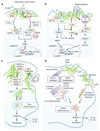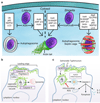The cytoskeleton in cell-autonomous immunity: structural determinants of host defence
- PMID: 26292640
- PMCID: PMC4869833
- DOI: 10.1038/nri3877
The cytoskeleton in cell-autonomous immunity: structural determinants of host defence
Abstract
Host cells use antimicrobial proteins, pathogen-restrictive compartmentalization and cell death in their defence against intracellular pathogens. Recent work has revealed that four components of the cytoskeleton--actin, microtubules, intermediate filaments and septins, which are well known for their roles in cell division, shape and movement--have important functions in innate immunity and cellular self-defence. Investigations using cellular and animal models have shown that these cytoskeletal proteins are crucial for sensing bacteria and for mobilizing effector mechanisms to eliminate them. In this Review, we highlight the emerging roles of the cytoskeleton as a structural determinant of cell-autonomous host defence.
Conflict of interest statement
The authors declare no competing interests.
Figures




References
-
- Pasparakis M, Vandenabeele P. Necroptosis and its role in inflammation. Nature. 2015;517:311–320. - PubMed
-
- Sridharan H, Upton JW. Programmed necrosis in microbial pathogenesis. Trends Microbiol. 2014;22:199–207. - PubMed
-
- Kawai T, Akira S. Toll-like receptors and their crosstalk with other innate receptors in infection and immunity. Immunity. 2011;34:637–650. - PubMed
-
- Yoneyama M, Onomoto K, Jogi M, Akaboshi T, Fujita T. Viral RNA detection by RIG-I-like receptors. Curr Opin Immunol. 2015;32C:48–53. - PubMed
Publication types
MeSH terms
Substances
Grants and funding
LinkOut - more resources
Full Text Sources
Other Literature Sources
Medical

